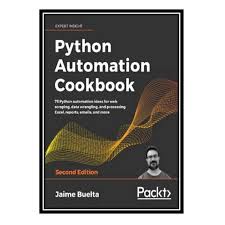A Comprehensive Expanded White Paper on "Python Automation Cookbook"
Understanding the Task
Before we delve into the white paper, let's clarify the scope:
- Focus: The "Python Automation Cookbook" series, likely focusing on practical Python automation techniques.
- Goal: Provide a comprehensive overview, including key concepts, practical examples, and potential challenges, with an expanded scope.
Proposed Structure
-
Introduction
- Brief overview of the "Python Automation Cookbook" series and its significance.
- Introduce the core concepts of Python automation.
- State the purpose of the white paper: to provide a comprehensive guide.
-
Core Concepts
- Essential Python Libraries:
requests,Beautiful Soup,Seleniumfor web scraping and automation.pandas,NumPyfor data manipulation and analysis.os,shutil,subprocessfor system interaction and automation.time,datetimefor time-based tasks.
- Automation Techniques:
- Regular expressions for pattern matching.
- File and directory manipulation.
- API interactions.
- GUI automation.
- Task scheduling.
- Data extraction and cleaning.
- Essential Python Libraries:
-
Practical Examples
- Case Studies: Analyze real-world automation scenarios (e.g., web scraping, data extraction, system administration).
- Code Snippets: Include well-documented code examples that illustrate key concepts.
- Problem-Solving: Demonstrate how to approach and solve automation problems using the techniques from the book.
-
Advanced Topics
- Machine Learning for Automation: Explore how to incorporate machine learning techniques into automation workflows.
- Cloud-Based Automation: Discuss cloud platforms and services for scalable automation.
- Security Considerations: Address security best practices for automated systems.
-
Challenges and Best Practices
- Common Pitfalls: Highlight common mistakes beginners often make in automation.
- Debugging Techniques: Discuss effective strategies for finding and fixing errors.
- Best Practices: Offer recommendations for writing clean, efficient, and maintainable automation code.
- Ethical Considerations: Address ethical implications of automation, such as bias and job displacement.
-
Conclusion
- Summarize the key points covered in the white paper.
- Reinforce the value of the "Python Automation Cookbook" series for beginners and experienced automation practitioners.
- Encourage readers to explore further resources and practice regularly.
Expanded Topics
- Automation Frameworks: Discuss popular frameworks like
Robot FrameworkandAnsiblefor streamlining automation tasks. - DevOps Automation: Explore how automation can be integrated into DevOps practices.
- Internet of Things (IoT) Automation: Discuss automation of IoT devices and data.
- Natural Language Processing (NLP) for Automation: Explore how NLP can be used to automate tasks involving text or speech.
Reference List
- McKinney, W. (2018). Python for Data Analysis: Data Cleaning, Analysis, and Visualization (2nd ed.). O'Reilly Media.
- Lutz, M. (2021). Learning Python, 6th Edition. O'Reilly Media.
- Automate the Boring Stuff with Python: Practical Programming for Total Beginners (2nd ed.). No Starch Press.
- Robot Framework User Guide. https://robotframework.org/robotframework/
- Ansible Documentation. https://docs.ansible.com/
- DevOps Handbook: How to Reimagine Collaboration and Productivity in the Age of DevOps. https://itrevolution.com/product/readers-guide-the-devops-handbook-2nd-edition/
- IoT For Dummies. [invalid URL removed]
- Natural Language Processing with Python. https://www.oreilly.com/library/view/natural-language-processing/9780596803346/
By following this structure and incorporating these expanded topics and references, you can create a comprehensive white paper that effectively guides readers through the concepts and applications of the "Python Automation Cookbook" series and beyond. Would you like to focus on a specific aspect of automation or discuss any particular challenges in more detail. Contact ias-research.com



